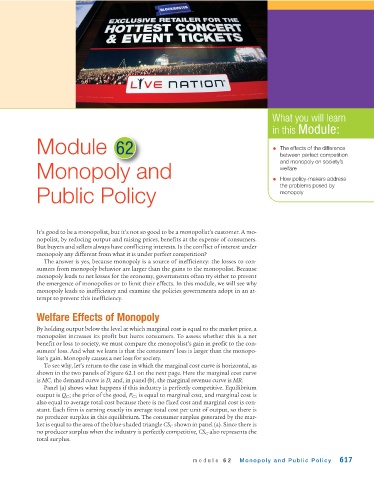Page 659 - Krugmans Economics for AP Text Book_Neat
P. 659
What you will learn
in this Module:
Module 62 • The effects of the difference
between perfect competition
and monopoly on society’s
Monopoly and welfare
• How policy-makers address
the problems posed by
Public Policy monopoly
It’s good to be a monopolist, but it’s not so good to be a monopolist’s customer. A mo-
nopolist, by reducing output and raising prices, benefits at the expense of consumers.
But buyers and sellers always have conflicting interests. Is the conflict of interest under
monopoly any different from what it is under perfect competition?
The answer is yes, because monopoly is a source of inefficiency: the losses to con-
sumers from monopoly behavior are larger than the gains to the monopolist. Because
monopoly leads to net losses for the economy, governments often try either to prevent
the emergence of monopolies or to limit their effects. In this module, we will see why
monopoly leads to inefficiency and examine the policies governments adopt in an at-
tempt to prevent this inefficiency.
Welfare Effects of Monopoly
By holding output below the level at which marginal cost is equal to the market price, a
monopolist increases its profit but hurts consumers. To assess whether this is a net
benefit or loss to society, we must compare the monopolist’s gain in profit to the con-
sumers’ loss. And what we learn is that the consumers’ loss is larger than the monopo-
list’s gain. Monopoly causes a net loss for society.
To see why, let’s return to the case in which the marginal cost curve is horizontal, as
shown in the two panels of Figure 62.1 on the next page. Here the marginal cost curve
is MC, the demand curve is D, and, in panel (b), the marginal revenue curve is MR.
Panel (a) shows what happens if this industry is perfectly competitive. Equilibrium
output is Q C ; the price of the good, P C , is equal to marginal cost, and marginal cost is
also equal to average total cost because there is no fixed cost and marginal cost is con-
stant. Each firm is earning exactly its average total cost per unit of output, so there is
no producer surplus in this equilibrium. The consumer surplus generated by the mar-
ket is equal to the area of the blue-shaded triangle CS C shown in panel (a). Since there is
no producer surplus when the industry is perfectly competitive, CS C also represents the
total surplus.
module 62 Monopoly and Public Policy 617

